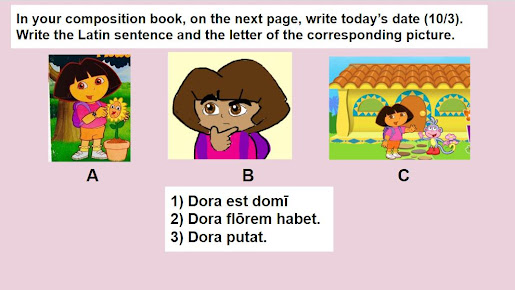I am starting my 27th year of teaching, and I have seen A LOT of educational trends and new "flavor of the day" initiatives come and go. One of them is bellringers (also known as do-nows, entry tickets, and openings), and it is something which my district has been really pushing this past year as part of its "I do, we do, you do" curriculum model. I have resisted the idea of bellringers, because I have always associated them with "cookie-cutter" educational frameworks. Plus, the world language examples which I have always seen relate to grammar-translation models, focus on L1 discussions about culture, or do not involve comprehensible language.
However, last year, my colleague John Foulk began to open his classes with a bellringer, and I was intrigued by this. In addition, this past summer at both the Fluency Matters Conference and the CI Summit, I had some good conversations with some CI/ADI folks about how they use bellringers successfully in their classes. I also then found Cindy Hitz's blog post about how she uses bellringers, and I decided to give it a try (Cindy was one of the first CI/ADI people whom I met - it was at the 2013 ACTFL Convention in Orlando, and she was working at the TPRS Books exhibitor book. Over the years, I have learned so much from Cindy at conference presentations and from her blog, and finally this summer at the Dallas Acquisition Academy, I was able to see her again in person after many years!).
When school began this past August, I started every day of my classes with a 5-minute bellringer. I DO NOT KNOW WHY I WAITED SO LONG TO DO THEM, BECAUSE I LOVE THEM! And yes, they can align with CI/ADI pedagogy and be communicative!
If you have not read Cindy's blog posts about bellringers, read it (link here). She does such a great job of explaining the purpose, gives examples of bellringers, and details her observations of their efficacy. My blog post here will mirror hers.
Examples of my bellringers (again, refer to Cindy's blog post here, since many of these mirror hers):
1) Vocabulary bellringers
3) Translation
4) Tables
5) Graphics/Writing
6) Cloze Sentences
7) Who Would Say? (yes, the man in the picture has three arms - the perils of using AI to create an image lol)
Observations - many of these line up with Cindy's own observations:
- Bellringers require commitment on your part so that it becomes part of the expected beginning-of-classroom routine.
- I am AMAZED by how focused students are after the bellringer is completed compared to when I did not implement them previously.
- The whole bellringer time should take 10 minutes - I give 5 minutes for students to complete it (while I take attendance) and 5 minutes to go over the bellringer as a class. My class periods are 53 minutes.
- The bellringer itself needs to connect with the current unit/lesson. The point of the bellringer is to activate current background knowledge needed for the day's lesson or to reinforce past knowledge.
- Bellringers are a source of input, so they need to be COMPREHENSIBLE! If they are not, then input disruptions occur, and the brain will toss out what it does not understand.
- Bellringers do not need to involve critical thinking/higher order thinking - the goal is just to transition students into an academic frame of mind.
- Bellringers need to be "easy" so that students feel successful with them. When students feel successful with bellringers, they are more apt to buy into them.
- Much like classroom activities, bellringers need to be scaffolded accordingly.
- I allow students to have their phones/listening devices out during the 5 minutes when they are completing the bellringer, but when that time is up and we are ready to go over it, I then begin my cell phone ritual.
- Bellringers need to involve students writing them down and interacting with them. I require students to have a composition book solely for bellringers. Partly I do this to ensure that students are doing the bellringer, but mainly more because...
- I use bellringers as a time to toss in pop-up theory! Daily I tell students, "Please write down the bellringer. Whenever you write down understandable messages in Latin, your brain makes a connection. That which the brain does not understand, it throws out. If there is a word which you do not understand, ask me so that your brain can start making a connection with that word!" I am sure that students are sick of hearing me say that lol.
What has your experience been with bellringers?










I love these ideas and your examples! I really want to try it- but the time!!! I am already working so much outside of school. How long does this take per class/prep? Any suggestions how to cut the time down?? Thank you :)
ReplyDeleteNow that I have an idea about variety in creating bellringers, it probably takes me 30 minutes to create 5 days worth of bellringer slides. It took me longer in the beginning, because I was still trying to figure things out and did not want to focus on grammar-translation bellringers.
Delete